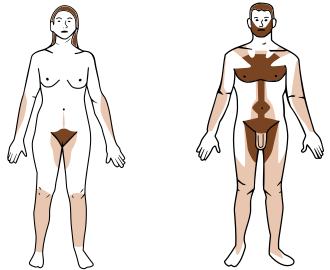
Back إزالة الشعر Arabic Обезкосмяване Bulgarian চুল অপসারণ Bengali/Bangla Disvleviñ Breton Depilació Catalan Körperhaarentfernung German Αποτρίχωση Greek Senharigo Esperanto Karvade eemaldamine Estonian Depilazio Basque

Hair removal is the deliberate removal of body hair or head hair. This process is also known as epilation or depilation.
Hair is a common feature of the human body, exhibiting considerable variation in thickness and length across different populations. Hair becomes more visible during and after puberty. Additionally, men typically exhibit thicker and more conspicuous body hair than women.[1] Both males and females have visible body hair on the head, eyebrows, eyelashes, armpits, genital area, arms, and legs. Males and some females may also have thicker hair growth on their face, abdomen, back, buttocks, anus, areola, chest, nostrils, and ears. Hair does not generally grow on the lips, back of the ear, the underside of the hands or feet, or on certain areas of the genitalia.
Hair removal may be practiced for cultural, aesthetic, hygienic, sexual, medical, or religious reasons. Forms of hair removal have been practiced in almost all human cultures since at least the Neolithic era. The methods used to remove hair have varied in different times and regions.
The term "depilation" is derived from the Medieval Latin "depilatio," which in turn is derived from the Latin "depilare," a word formed from the prefix "de-" and the root "pilus," meaning "hair."
- ^ Shellow V (2006). Encyclopedia of Hair: A Cultural History. Greenwood Publishing Group. p. 67. ISBN 0-313-33145-6.)